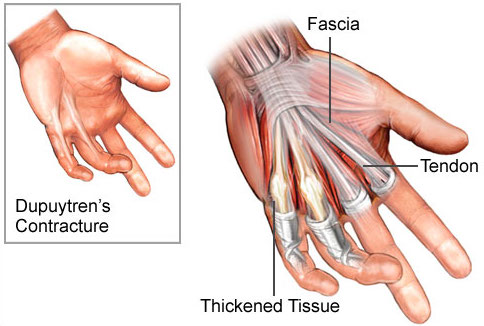What is it?
Dupuytren’s Disease is a genetic disorder affecting the connective tissue of the palm of the hand. Established contractures are irreversible and require surgery.

Signs and Symptoms
- The first sign is often a small lump or puckering of the skin which can progress into a thickened fascial band or “cord”.
- The thick cord of fascia pulls the fingers in toward the palm.
- Often occurs in both hands and the soles of the feet and is most common in the Little finger and the Ring finger.
- The condition is painless and benign for most, however, those that use their hands for heavy gripping, and manual handling tasks, can exacerbate the condition.
Causes
The exact cause of Dupuytren’s is unknown. One theory is that it descends from the Viking era. The condition can also present following trauma to the fingers, hand and wrist.
Incidence
Dupuytren’s most frequently occurs in men over the age of 40 and people of Northern European descent.
Surgery
There are 3 main surgical interventions:
- Fasciectomy – A ‘Z’ shaped incision is made into the palm / fingers and the Dupuytren’s tissue is removed.
- Needle Fasciotomy – A needle is used to cut the Dupuytren’s tissue and break the cord.
- Collagenase – Collagenase is a solution which is injected into the cord of the Dupuytren’s to dissolve the tissue.
Post – Surgery Treatment
- Splinting will help prevent the contracture recurring as the wound heals and the scar matures. Night splinting is required for 12-16 weeks post-operatively depending on the severity of the condition and the surgeon’s preference.

- A compression glove may be provided to reduce swelling and provide pressure to the palm, particularly following a Collagenase injection.

- Tendon Gliding Exercises help prevent scar adhesions and maintain joint range of motion.
- Ultrasound, Low Level Laser Therapy, scar massage and silicone may be used to assist with remodelling of scar tissue.
- Strengthening exercises are provided to assist you to return to full activities.